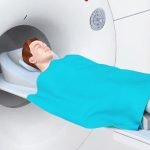What is an echocardiogram?
An echocardiogram, or echo, is a noninvasive, diagnostic test that uses high frequency sound waves to provide a picture of the heart’s movement, valves, and chambers. An echo is essentially the same as a pregnancy ultrasound, except instead of seeing the baby you see the heart. There are several different types of echocardiograms; the most common ones for diagnosing heart disease are:

- M-mode – gives a one-dimensional view of the heart as if a line were drawn through it
- 2-dimensional (2-D) or 3-D – show the length and width of the structures in the heart
- Doppler – measures blood flow through the heart and blood vessels
A woman having an echocardiogram test.
What is a stress echocardiogram?
Some heart problems only show up when the heart is working hard (or stressed). A stress echocardiogram is done while you exercise to see if there are any areas of your heart that do not get enough blood and oxygen when under stress. In women unable to exercise, a chemical stress echo may be performed using chemicals that mimic the effect of exercise on the heart.
Who might have an echocardiogram?
Echocardiograms are generally used in women with symptoms suggestive of heart disease such as chest pain or shortness of breath, or those at risk for heart disease who had previous abnormal tests such as an ECG. Echo is also used to diagnose heart rhythm problems and heart murmur.
The Echo Procedure
How do I prepare for a resting or stress echocardiogram?
There is no special preparation for a resting echo. You should not eat, drink, or smoke for about four hours before a stress echo. You may be asked to avoid caffeine for up to 24 hours before the test. If you have diabetes, you should discuss dietary concerns with your healthcare provider to control your blood sugar levels. Talk to your doctor about any medications you are taking in case they affect the accuracy of the test. You may be asked to stop taking some medications (such as beta blockers) a few days before the test. For a stress echo using exercise, you should wear comfortable, loose clothing and shoes appropriate for exercising and you should remove all jewelry.
What does a resting or stress echocardiogram entail?
You will strip from the waist up (you can keep your bra on) and put on a hospital gown. A physician or technician will hook you up to an ECG by placing three electrodes on your chest using small sticky patches. You will then lie on your left side on an exam table. A technician called a sonographer will perform the echo while a physician supervises. A cool, colorless gel will be applied to your chest and to the end of a wand, called a transducer. The wand will be gently rubbed across your chest and you should feel a gentle pressure, but no pain. The sonographer may ask you to change position in order to get pictures at different angles. You may also be asked to hold your breath briefly during some parts of the test. The wand sends and receives sound waves through your chest. The soundwaves are analyzed to create a picture of your heart that is viewed on a nearby monitor and recorded on videotape or computer disk. Sometimes a contrast dye is used to get better pictures. If this happens, you will feel a warm sensation when the dye will be injected through an IV line in your arm.
For a stress echo, the nurse or technician will determine your target heart rate based on your age, height, weight, and what medications you currently take. You will wear a blood pressure cuff on your arm for the exercise portion. You will probably exercise on a treadmill or a stationary bike. When you have reached your target heart rate or when you ask to stop because of fatigue or symptoms, this portion will end. You will quickly go back to the table and lie on your left-hand side for another echocardiogram while your heart rate is high.
If you are unable to exercise, possibly due to older age, arthritis, or excess weight, a chemical stress echo (also called a pharmacological stress echo) will be performed. You will take a drug, such as dobutamine or adenosine, that mimics the effect of exercise on the heart while you remain at rest throughout the test. A resting echocardiogram will take about 30 minutes, and a stress echocardiogram can take one to two hours.
What happens after a resting or stress echocardiogram?
You may resume your normal activities after an echocardiogram. The gel is wiped off and you can get dressed and leave. If you had a chemical stress echocardiogram, you may experience some minor side effects from the medication including nausea, heart palpitations, numbness in the arms or legs, flushing, chest pain, or headaches. If a contrast dye was used, you should drink fluids to wash out the dye. If you don’t exercise regularly, you may feel chest pain, tiredness, muscle aches, and shortness of breath afterwards.
Echo Test Results
What does a negative (normal) echo indicate?
Women with a negative (normal) resting or stress echo are at low risk for developing future heart problems including heart attack.1,2 In women already diagnosed with heart disease, a normal stress echo suggests a less than 1% annual risk of death. This risk is higher (about 4%) for women with diabetes.3
What does a positive echo indicate?
Women with a positive (abnormal) echo have an increased risk of experiencing heart problems including dying or having a heart attack than women with a negative test. The risks are higher if your test shows severe abnormalities compared with mild to moderate abnormalities.4 Your health care provider will discuss the results with you and prescribe further tests or treatments.
If you had an exercise stress echo, your fitness level and response to exercise can tell a lot about your risk for future heart problems (see Exercise ECG for details).
Is echocardiogram testing accurate in women?
Echocardiography has a similar accuracy in men and women. A positive or negative echo means the same for men and women. That is, women with a positive (abnormal) test have the same risk of dying or having a heart attack as men with a positive echo, and women with a negative (normal) test will fare just as well as men with a negative test.5
Echo Risks & Limitations
Are there any risks with echocardiography?
Echocardiography testing is very safe and it does not involve radiation. There is a small risk of side effects with the chemicals used in chemical stress tests.6, 7 The contrast dye that is sometimes used may trigger an allergic reaction. It can also damage the kidneys in people with diabetes or previous kidney damage. You should tell your healthcare provider if you have had a reaction to X-ray dye, shellfish, or iodine in the past.
Does a resting or stress echocardiogram have any limitations?
An echo may not give accurate results if you are obese or have been diagnosed with chronic obstructive pulmonary disease, such as emphysema or chronic bronchitis, or if you have surgical incisions. In women who are obese or have large breasts, the image produced by echocardiography may appear fuzzy making it difficult to interpret. These women may have a transesophageal echo—in which the wand (transducer) is passed down the windpipe (or esophagus) to visualize the heart. This type of echo can be uncomfortable; you may be sedated to ease the discomfort. The accuracy of echo testing may be affected by some heart medications (including nitrates, calcium channel blockers, or beta blockers).8 Your doctor will tell you whether you should stop taking any medications before the test. In some cases, you can continue taking your medications and this will be taken into account when it comes to interpreting the test results.
Echocardiography also requires skill and experience; the results may vary depending on how well the test was done.9-11 New developments to improve image quality will make it easier to get the same results no matter who does the test.12
References
1. Sicari R, Pasanisi E, Venneri L, et al. Stress echo results predict mortality: a large-scale multicenter prospective international study. J Am Coll Cardiol. 2003;41:589-595.
2. Dhond MR, Nguyen TT, Sabapathy R, Patrawala RA, Bommer WJ. Dobutamine stress echocardiography in preoperative and long-term postoperative risk assessment of elderly patients. Am J Geriatr Cardiol. 2003;12:107-109, 112.
3. Marwick TH, Case C, Sawada S, et al. Use of stress echocardiography to predict mortality in patients with diabetes and known or suspected coronary artery disease. Diabetes Care. 2002;25:1042-1048.
4. Yao SS, Qureshi E, Sherrid MV, Chaudhry FA. Practical applications in stress echocardiography: risk stratification and prognosis in patients with known or suspected ischemic heart disease. J Am Coll Cardiol. 2003;42:1084-1090.
5. Nasir K, Redberg RF, Budoff MJ, et al. Utility of Stress Testing and Coronary Calcification Measurement for Detection of Coronary Artery Disease in Women. Arch Intern Med. 2004;164:1610-1620.
6. Picano E, Marini C, Pirelli S, et al. Safety of intravenous high-dose dipyridamole echocardiography. The Echo-Persantine International Cooperative Study Group. Am J Cardiol. 1992;70:252-258.
7. Picano E, Mathias W, Jr., Pingitore A, Bigi R, Previtali M. Safety and tolerability of dobutamine-atropine stress echocardiography: a prospective, multicentre study. Echo Dobutamine International Cooperative Study Group. Lancet. 1994;344:1190-1192.
8. Sicari R, Cortigiani L, Bigi R, et al. Prognostic Value of Pharmacological Stress Echocardiography Is Affected by Concomitant Antiischemic Therapy at the Time of Testing. Circulation. 2004;109:2428-2431.
9. Picano E, Lattanzi F, Orlandini A, Marini C, L’Abbate A. Stress echocardiography and the human factor: the importance of being expert. J Am Coll Cardiol. 1991;17:666-669.
10. Hoffmann R, Lethen H, Marwick T, et al. Analysis of interinstitutional observer agreement in interpretation of dobutamine stress echocardiograms. J Am Coll Cardiol. 1996;27:330-336.
11. Hoffmann R, Lethen H, Marwick T, et al. Standardized guidelines for the interpretation of dobutamine echocardiography reduce interinstitutional variance in interpretation. Am J Cardiol. 1998;82:1520-1524.
12. Hoffmann R, Marwick TH, Poldermans D, et al. Refinements in stress echocardiographic techniques improve inter-institutional agreement in interpretation of dobutamine stress echocardiograms. Eur Heart J. 2002;23:821-829.








